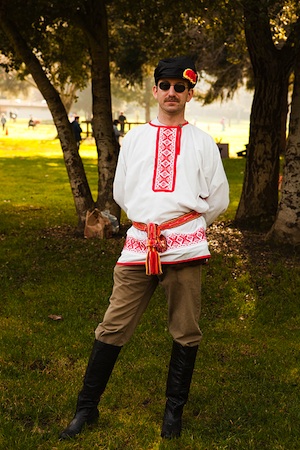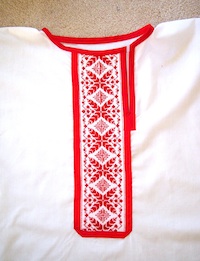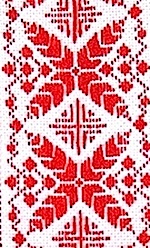
|
Outfits >>>
Replicas >>>
Man's shirt decorated with ritual "Kupala" embroidery | ||

|
| |
|
In Slavic tradition, crosses (both X-like and + -like ones) symbolized Fire. X-cross was used for Heavenly Fire (Sun, thunderbolt). Russian peasants called an X-like cross as ognevets ("caused by fire and closely related to it"). That sign was both a very archaic and a persistent one. Remains of huge and, obviously, perennial X-like sacred fires have been excavated by researchers around all pre-Slavic territory of living. Those zolniki ("piles of ashes") belonged to different periods of time, from 1000's BC to 1700's AD. And, even in the 19th century Slavs of Karpaty mountains made their ritual fireplaces in a shape of ognevets: it was believed as protection from thunderstorm. X-cross composed of two criscrossed tree branches was not natural for Slavic mythology. Pre-Slavs adopted it from an Indo-Iranian system of beliefs. Indo-Iranians inhabited Ukrainian steppes in the 4th - 6th centuries AD. Their contribution to Southern-Slavic languages, fairy-tales, and troponomy can be noticed even nowadays. For Iranians, the design mentioned above depicted mysterious Green Fire — a symbol of life and vital energy. In Russian paganism, however, that idea didn't persist. Only traces of it were preserved in summer solstice ritual songs, and designs of ritual men's shirts. + - like cross depicted Earthly Fire in Slavic tradition. Scientists believe the reason for it was similarity of + and two crossed sticks used for making "living fire" - the one produced by friction. Slavs considered Living Fire as an ambassador of Heavenly one sent to the human world. Being a sibling of Sun and Thunderstorm (in accordance to Russian pagan beliefs), It shared the Sun's ability to produce a plentiful harvest, abundance, and wealth. Speaking of Kupala (summer solstice) celebration, Kupala ritual fire must be started with Living Fire. As a whole, the design we describe consists of floral X-crosses - Green Fire, +s - a ritual fire, and a zig-zag border - a common Indo-European sign for water. Life, Tree, Fire, Water - it is exactly a combination of energies and spirits worshipped at Kupala.
| ||
Sources (in Russian)
| ||

